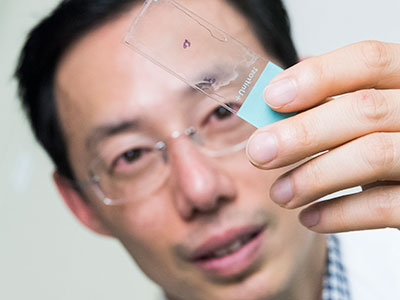Finding new ways to fight hemorrhagic cystitis for cancer patients

Children diagnosed with cancer face fear and uncertainty, a series of medical appointments, and multiple diagnostic tests and treatments.
Children diagnosed with cancer face fear and uncertainty, a series of medical appointments, and multiple diagnostic tests and treatments. On top of these challenges, says Children’s National Health System urologist Michael Hsieh, M.D., Ph.D., many patients contend with additional issues: Treatment side effects, discomforts, and dangers that nearly eclipse that of the cancer itself. One of the most common side effects is hemorrhagic cystitis (HC), a problem marked by extreme inflammation in the bladder that can lead to tremendous pain and bleeding.
HC often results from administering two common chemotherapy drugs, cyclophosphamide and ifosfamide, used to treat a wide variety of pediatric cancers, including leukemias and cancers of the eye and nerves. In the United States alone, nearly 400,000 patients of all ages receive these drugs annually. Of these, up to 40 percent develop some form of HC, from symptomatic disease characterized by pain and bloody urine to cellular changes to the bladder detected by microscopic analysis.
“Having to deal with therapy complications makes the cancer ordeal so much worse for our patients,” says Dr. Hsieh, Director of the Clinic for Adolescent and Adult Pediatric Onset Urology at Children’s National. “Being able to eliminate this extremely detrimental side effect once and for all could have an enormous impact on patients at our hospital and around the world.”
Preventing complications with mesna
The severity of side effects from cyclophosphamide and ifosfamide can vary from mild and fleeting to bladder bleeding so extensive that patients require multiple transfusions and surgery to remove blood clots that can obstruct urinary release, says Dr. Hsieh, who frequently treats patients with this condition. But HC isn’t inevitable, he adds. A drug called mesna has the potential to prevent this complication when prescribed before a patient receives chemotherapy.
The problem is for a fraction of patients, mesna simply doesn’t work. For others, mesna can cause its own serious side effects, such as life-threatening malfunctions of the heart’s electrical system or allergic reactions.
“These kids are often already very sick from their cancers and treatments, and then you compound it with these complications,” says Dr. Hsieh. “There’s a desperate need for alternatives to mesna.”
Looking at alternative treatments
In a new review of the scientific literature, published August 24 by Urology, senior author Dr. Hsieh and a colleague detail all the substitutes for this drug that researchers have examined over several years.
One of these is hyperhydration, or delivering extra fluid intravenously to help flush the bladder and keep dangerous chemotherapy drug metabolites from accumulating and causing damage. Hyperhydration, however, isn’t an option for some patients with kidney, lung, or liver problems, who can’t tolerate excess fluid.
Researchers also have invested heavily in antioxidants as alternative treatments. Because much of the damage caused by these chemotherapy agents is thought to result from a cascade of oxidizing free radicals that cyclophosphamide and ifosfamide launch in the bladder, antioxidants might prevent injury by halting the free radical attack. Antioxidants that researchers have explored for this purpose include cytokines, or immune-signaling molecules, known as interleukin-1 and tumor necrosis factor, and a compound called reduced glutathione. Other studies have tested plant-based antioxidants, including a component of red wine known as resveratrol; a compound called diallyl disulfide isolated from garlic oil; and extracts from Uncaria tomentosa, a woody vine commonly known as “cat’s claw” that grows in the jungles of Central and South America.
Researchers also have tested options that focus on reducing the intense inflammation that cyclophosphamide and ifosfamide cause in the bladder, including the corticoid steroid drug dexamethasone as well as another cytokine known as interleukin-4.
However, Dr. Hsieh says, studies have shown that each of these treatments is inferior to mesna. To truly combat HC, researchers not only need to find new drugs and methods that outperform mesna but also new ways to reverse HC after other measures fail—problems he’s working to solve in his own lab.







